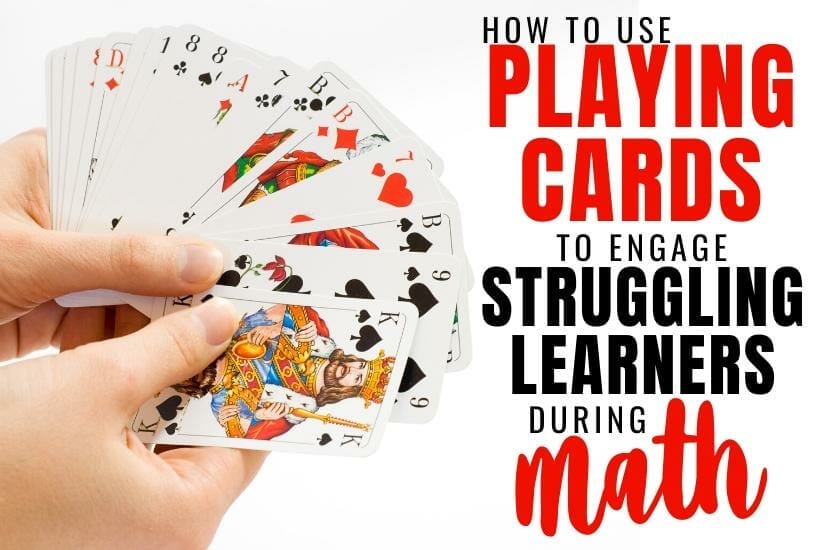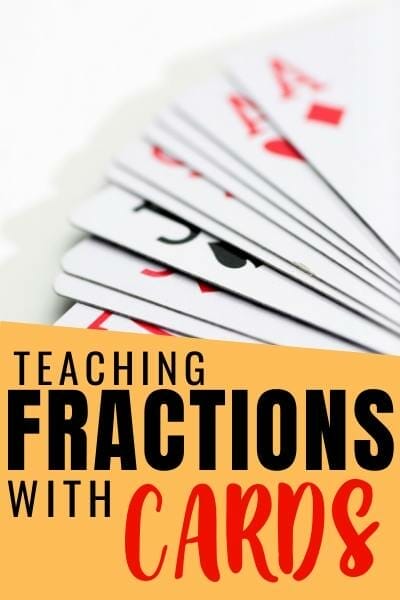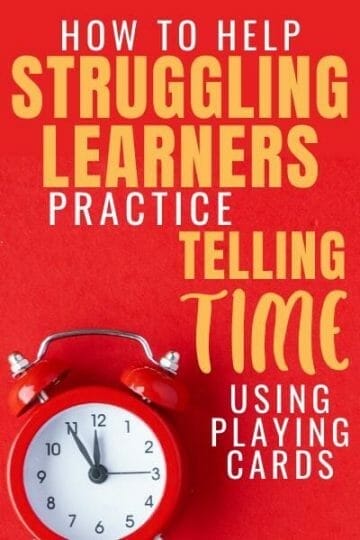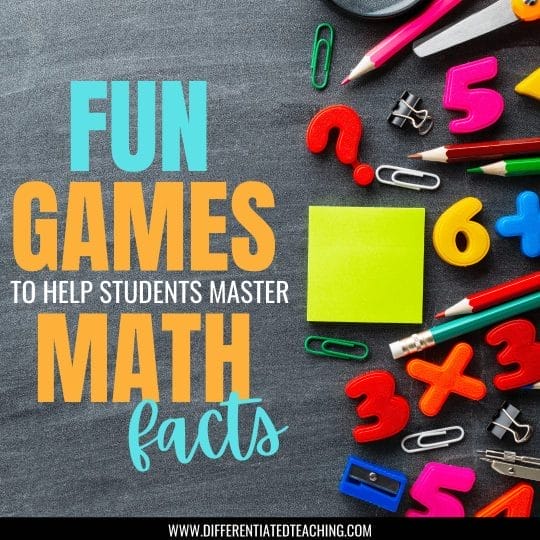How to Teach Math Skills with a Deck of Cards
When students struggle with math, it can be hard to find ways to engage them and keep them practicing essential skills without boring worksheets or rote practice. However, understanding math concepts and being fluent with basic computation are two important factors for long-term success in mathematics.
Today I wanted to share some engaging ways to make practicing math skills fun for your struggling learners and for many of the activities all you’ll need is some playing cards!

10 Engaging Games that Use Playing Cards to Engage Struggling Learners in Math
Many students require repeated practice to master concepts introduced in class. However, our jam-packed curriculum combined with limited resources can make it difficult to continue to practice these skills in ways that are fun and engaging for students.
One simple way is to introduce simple math games that students can play to practice important foundational skills and computational fluency. Most of the activities below only require a pack of playing cards and are sure to keep your struggling math students on-task. I’ve broken them down by skill to make finding what you need quick and easy.
Computational Fluency
Below are four math playing card math games and activities that will help your students build computational fluency skills. Math fact fluency is a foundational part of being able to quickly and efficiently approach higher-level mathematics and word problems.

Nifty Fifty – Addition
One of our favorite games to practice mental addition is called ‘nifty fifty’. The idea is that you carry on adding until you get to fifty.
Turn over the playing cards one at a time, revealing a new one each time the child has managed to add the previous. For example, if the first card is 6 and the second one is 3 when they have answered 9, pick another. They should then add that number to 9.
To use this as a partner game, you can have students take turns selecting cards and adding them to the sum. Whoever picks the card that gets the sum at or above 50 wins!
Zero the Hero – Subtraction
‘Zero the Hero’ is a great game to play to practice taking numbers away. Start with a number, such as 50, the child should keep taking numbers away until they reach 0. If they are left with 5 and reveal a 6, they need to choose another card.
This makes a great partner or small group game. Just like the game above, you can have students take turns selecting cards until they reach a difference of exactly zero.
Multiplication War – Multiplication
Learning times tables by rote can be both useful and dull. Encouraging children to practice these tables regularly is vital. Using a pack of playing cards can be a simple way to do this.
First, decide whether you want to include 1x facts in your game. If you do plan to include these, remove the jacks, queens, and kings. Leave aces in. If you aren’t including facts x1, you can remove the aces as well.
If students work in pairs, shuffle the pack and deal cards to both learners. The first should turn over their card; the other child does the same. Students should work out the product of the two numbers as quickly as possible.
Whoever says the correct answer first can keep the cards and place them at the bottom of their pile.
If no one gets it, they can swap the cards and place them at the bottom.
Mixed Practice – Number Talks
Turn over one or two cards (if making a 2-digit number). As quickly as the students can, get them to write as many calculations as possible that equal the generated number. This can be great practice for simple number facts and a perfect addition to your number talks.
To challenge your students, use the playing cards to place onto prepared templates for addition, subtraction, multiplication, and division questions. For example, if your child has moved onto multiplication involving decimals, your template would reflect this. You can make this as easy or challenging as you need to.
After you’ve introduced these games, you can add some digital fact practice with these fun online math fact games.
Fractions
For this activity, you will require a sheet of squared paper, pencil, and ruler in addition to the pack of cards. You should also have something to create the fraction bar such as a piece of string or a stick.
Place cards face down on the table. Have your students choose two and place them either side of the fraction bar.
Remember to use the correct terminology of the numerator (top number) and denominator (bottom number).
Next, use the fraction created to draw a shape and shade in that fraction.

For more advanced learners or those who are in later grades, do not insist on the number with the greatest value always being the denominator. Create improper fractions and give them an opportunity to create and visualize how these appear. You can even use this activity as a way to practice converting between improper fractions and mixed numbers.
Time
You may be wondering how on earth you can combine a pack of playing cards with the learning objective of telling the time. You will need a clock, but this can be a really fun activity. In fact, children often beg to play it again.

Simply pick three numbers from the pack. Write that number down as the digital time. Next, either draw the time onto an analog clock.
Alternatively, you could make your own clocks using cardboard and brads, then show the time on there. Such a simple idea, but it really is a hit.
If children are working in pairs, you could get the card picker to conceal the cards they chose by turning them over. The other child could guess what the digital time is based on where the clock’s hands are.
Place Value
Shuffle the number cards and deal out three. Turn them over and place them to create a three-digit number. Challenge the child to tell you what the number is.
Which digit is in the hundreds column?
Is that the greatest value number you could have made?
What’s the lowest value number you could have created?
You can extend this to more columns and even decimals depending on the ability of the child.
If you need more strategies for teaching place value, check out this article for tips and ideas: How to Simplify Place Value to Help Struggling Learners
20 Questions – Properties of Numbers
This is such a fun activity that can be used with any properties of numbers.
Pick a card at random from the pack. Other students can ask questions to try to guess which number is could be.
These should only be answered yes or no. Is it an odd number?
Is it less than five?
Can it be divided by 2?
Is it a prime number?
You can add to the challenge by picking another card to generate a two-digit number.
You can adapt this to ‘who am I?’ by making a headband to hold a playing card (or several) with the child wearing the number and having to ask the questions to discover their own identity.
Area & Perimeter
Area and perimeter can be overwhelming for struggling learners. Many students need lots of repetition to really master these skills. Using playing cards can make this review seem more game-like than your typical worksheet.

Here’s one way to review perimeter and area using playing cards. First, turn over two cards to reveal the dimensions for a quadrilateral. For example, a 7 and a 9 would mean that, on squared paper, the child would use a ruler to draw a rectangle measuring 7cm by 9cm.
Once they’ve got their rectangle drawn and labeled, they can then use their diagram to calculate the perimeter and area.
When doing this in a small group, ask students questions to get them exploring. Are there more ways of making an area of 24 square centimeters?
Look back at the different shapes drawn and check to see if there are some with the same calculated area or perimeter.
If you want more strategies and resources for teaching perimeter and area, check out this article: Tips, Tricks, and Free Activities for Teaching Perimeter & Area
Exploration with Number Lines
Using a piece of masking tape, mark out a long line on the floor. The numbers you mark at either end depends on the ability of the child. For example, struggling learners in lower grades may do best with a number line from 0 to 10.
Get the child to choose a card from the pack and think about where it might go on the number line. Challenge them even further by asking them to explain why they chose that location.
This can also be done using cards to create two-digit or decimal numbers for upper elementary grades.

Engaging Hands-on Activities Keep Struggling Math Students Engaged
Finding engaging ways to teach and review important math concepts is critical for struggling and reluctant learners
When students struggle with the foundations of math they often feel overwhelmed. By finding ways to incorporate activities that are hands-on and interactive into your small group instruction and partner practice, your learners have a chance to master the foundational components of the skill in a way that keeps them excited about learning.






